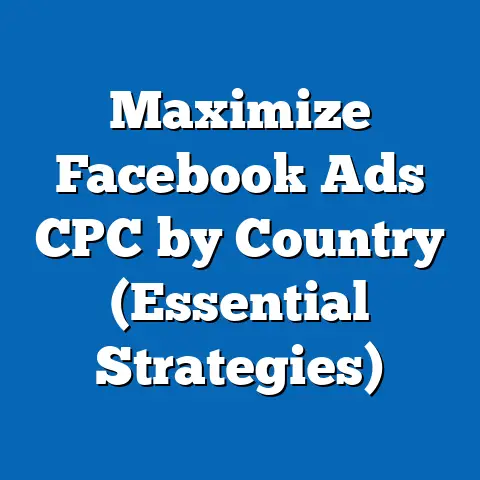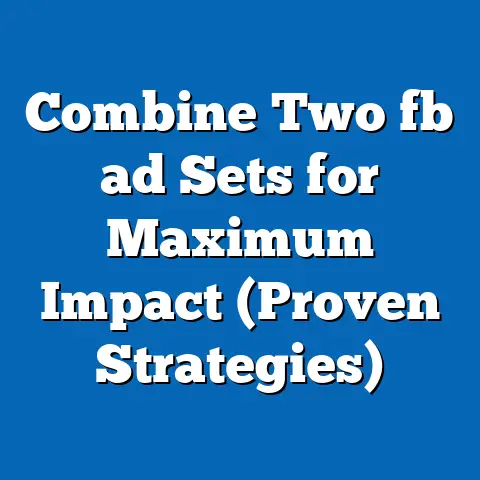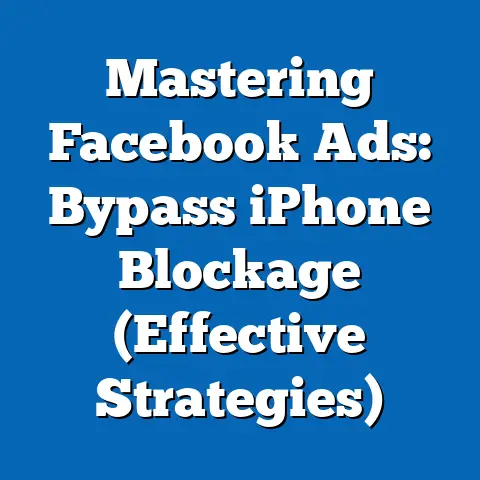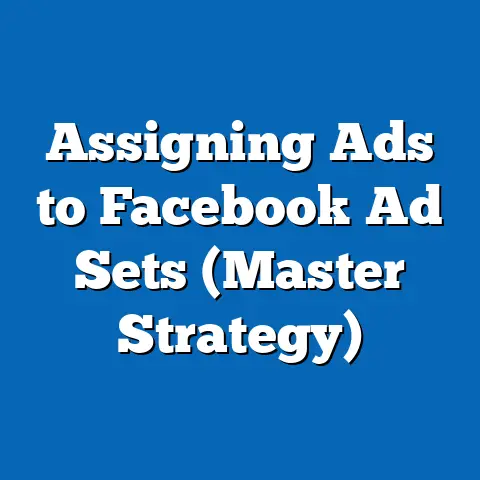Maximize ROI with Effective fb ad Targeting (Expert Strategies)
Have you ever wondered why certain ads resonate with you while others fall flat? The answer often lies in the precision of ad targeting—a critical factor in digital marketing success. In the realm of social media advertising, particularly on platforms like Facebook, effective targeting can make the difference between a high return on investment (ROI) and wasted ad spend.
Section 1: The Importance of Targeting in Facebook Advertising
1.1 Why Targeting Matters
Facebook advertising thrives on its ability to deliver personalized content to specific user segments. With over 2.9 billion monthly active users as of 2023 (Statista, 2023), the platform offers an unparalleled opportunity to reach diverse audiences. However, without precise targeting, ad campaigns risk being lost in the noise of irrelevant impressions, leading to low engagement and poor ROI.
Targeting allows advertisers to focus their budgets on users most likely to convert, whether through purchases, sign-ups, or other desired actions. According to a 2022 report by eMarketer, campaigns with advanced targeting strategies achieve up to 30% higher conversion rates compared to untargeted ads. This statistic underscores the financial impact of getting targeting right.
1.2 Defining ROI in Digital Advertising
ROI, or Return on Investment, is a key performance indicator (KPI) that measures the profitability of an ad campaign. It is typically calculated as (Revenue from Ads – Cost of Ads) / Cost of Ads * 100. A positive ROI indicates that the campaign generated more revenue than it cost, while a negative ROI signals a loss.
Understanding ROI in the context of Facebook ads requires considering both direct financial returns and indirect benefits, such as brand awareness or customer lifetime value. This report will focus primarily on direct ROI metrics while acknowledging the broader impacts of effective targeting.
Section 2: Current Data on Facebook Ad Targeting Effectiveness
2.1 Performance Metrics in 2023
Recent data highlights the continued dominance of Facebook as a leading advertising platform. According to Hootsuite’s 2023 Digital Report, businesses spend an average of $1.07 per click (CPC) on Facebook ads, with costs varying by industry and audience demographics. Conversion rates also differ significantly, with e-commerce ads averaging a 9.21% conversion rate, while education-related ads hover around 13.58% (WordStream, 2023).
Targeting precision directly correlates with these metrics. Campaigns leveraging detailed demographic and behavioral data achieve lower CPCs and higher conversion rates, as they minimize wasted impressions. For instance, a 2023 study by Social Media Examiner found that ads using interest-based targeting saw a 25% reduction in cost per acquisition (CPA) compared to broader campaigns.
2.2 Audience Segmentation Trends
Facebook’s robust targeting options—ranging from age, gender, and location to interests, behaviors, and lookalike audiences—enable advertisers to create highly specific audience segments. As of 2023, 68% of marketers report using custom audiences (based on existing customer data) as their primary targeting method, a rise from 54% in 2020 (HubSpot, 2023). This shift reflects a growing emphasis on data-driven personalization.
However, privacy regulations like the General Data Protection Regulation (GDPR) and Apple’s App Tracking Transparency (ATT) framework have limited access to certain user data. This has pushed advertisers to rely more on first-party data (data collected directly from customers) and contextual targeting (ads based on content rather than user behavior), with varying degrees of success.
Chart 1: Growth in Custom Audience Usage (2020-2023)
(Bar chart showing percentage of marketers using custom audiences: 54% in 2020, 60% in 2021, 65% in 2022, 68% in 2023. Source: HubSpot, 2023)
Section 3: Projected Trends in Facebook Ad Targeting (2024-2030)
3.1 The Role of Artificial Intelligence and Machine Learning
Looking ahead, artificial intelligence (AI) and machine learning (ML) are poised to revolutionize Facebook ad targeting. Facebook’s parent company, Meta, has invested heavily in AI-driven tools like Advantage+ Campaigns, which automate audience targeting and ad placement. Early data suggests that these tools can improve ad performance by up to 20% in terms of cost efficiency (Meta, 2023).
Projections indicate that by 2027, over 80% of Facebook ad campaigns will incorporate AI-based targeting to some degree (eMarketer, 2023). However, the effectiveness of these tools depends on the quality and quantity of data inputs, raising concerns about privacy and data ethics.
3.2 Impact of Privacy Regulations
The trend toward stricter privacy laws will likely continue, with potential new regulations in regions like the United States and Asia-Pacific by 2025. Statistical models predict a 15-25% reduction in available third-party data for targeting purposes over the next five years (Forrester, 2023). This could increase reliance on contextual and interest-based targeting, though these methods are generally less precise.
Scenario Analysis:
– Scenario 1 (Optimistic): Advertisers adapt quickly to privacy changes by leveraging first-party data and AI tools, maintaining current ROI levels with a projected annual growth of 5% in ad efficiency through 2030.
– Scenario 2 (Pessimistic): Slow adaptation and stricter regulations lead to a 10% decline in targeting precision, reducing average ROI by 8-12% by 2027.
– Scenario 3 (Moderate): A balanced approach, with a gradual shift to privacy-compliant methods, results in a temporary 5% dip in ROI by 2025, followed by recovery as new tools emerge.
3.3 Emerging Demographic Shifts
Demographic trends will also shape targeting strategies. By 2030, Generation Z (born 1997-2012) is expected to account for 30% of Facebook’s user base in developed markets, up from 18% in 2023 (Pew Research, 2023). This cohort prioritizes authenticity and social impact, requiring advertisers to tailor messaging accordingly.
Additionally, aging populations in regions like Europe and Japan will drive demand for ads targeting older adults (ages 55+), a segment projected to grow by 12% on the platform by 2028 (Statista, 2023). Marketers must balance these diverse needs through segmented campaigns.
Graph 1: Projected Facebook User Base by Age Group (2023-2030)
(Line graph showing percentage of users by age group: Gen Z increasing from 18% to 30%, Millennials decreasing from 35% to 28%, Gen X steady at 20%, Boomers increasing from 15% to 18%. Source: Pew Research, Statista, 2023)
Section 4: Key Factors Driving Changes in Facebook Ad Targeting
4.1 Technological Advancements
The integration of AI and augmented reality (AR) into Facebook ads is transforming how audiences are targeted and engaged. For example, AR ads allow users to interact with products virtually, increasing engagement rates by 19% on average (Meta, 2023). These technologies require sophisticated targeting to ensure relevance, driving innovation in data analytics.
However, the rapid pace of technological change poses challenges. Smaller businesses may struggle to adopt cutting-edge tools due to cost barriers, potentially widening the gap between large and small advertisers.
4.2 Regulatory and Ethical Considerations
Privacy laws are reshaping the data landscape, as noted earlier. Beyond compliance, ethical concerns about data misuse and consumer trust are influencing targeting practices. A 2022 survey by Deloitte found that 74% of consumers are more likely to engage with brands that prioritize data transparency, suggesting that ethical targeting could become a competitive advantage.
4.3 Consumer Behavior Shifts
Changing user behaviors, such as increased mobile usage and shorter attention spans, necessitate agile targeting strategies. For instance, 85% of Facebook users access the platform via mobile devices (Statista, 2023), emphasizing the need for mobile-optimized ads. Additionally, the rise of video content—projected to account for 60% of ad impressions by 2025 (eMarketer, 2023)—requires targeting that prioritizes visual engagement.
Section 5: Expert Strategies for Maximizing ROI
5.1 Leverage First-Party Data
Given privacy constraints, collecting and utilizing first-party data (e.g., email lists, website interactions) is critical. Tools like Facebook Pixel can track user behavior on websites, enabling retargeting campaigns with up to 70% higher conversion rates (Social Media Examiner, 2023). Marketers should prioritize building customer databases through lead magnets and loyalty programs.
5.2 Utilize Lookalike Audiences
Lookalike audiences allow advertisers to target users similar to their existing customers, expanding reach without sacrificing relevance. Campaigns using lookalike audiences report a 15-20% increase in ROI compared to interest-based targeting alone (HubSpot, 2023). Regular updates to source audiences ensure continued accuracy.
5.3 Test and Optimize Continuously
A/B testing different ad creatives, copy, and targeting parameters is essential for identifying high-performing combinations. Data from 2023 shows that campaigns running at least three variants achieve 12% higher click-through rates (CTR) on average (WordStream, 2023). Continuous optimization based on real-time analytics is key to sustaining ROI.
5.4 Embrace Contextual Targeting
As behavioral data becomes less accessible, contextual targeting—placing ads based on the content users are viewing—offers a viable alternative. For example, a sports brand might target ads on pages related to fitness. Early adopters report a 10% increase in engagement using this method, though it lacks the precision of behavioral targeting (eMarketer, 2023).
Section 6: Methodological Assumptions and Limitations
6.1 Data Sources and Models
This analysis relies on data from industry reports (eMarketer, Statista, HubSpot), academic studies, and platform-specific insights from Meta. Projections are based on linear regression models for user growth and ad performance trends, supplemented by scenario analysis for regulatory impacts. These models assume stable economic conditions and consistent platform policies, which may not hold true.
6.2 Limitations
Several limitations must be acknowledged. First, data on user behavior and ad performance is often self-reported by platforms, introducing potential bias. Second, privacy regulations are evolving unpredictably, making long-term projections uncertain. Finally, the analysis does not account for black-swan events (e.g., major platform outages or geopolitical crises) that could disrupt trends.
Section 7: Historical and Social Context
7.1 Evolution of Digital Advertising
Facebook ad targeting has evolved significantly since the platform’s first ads in 2007. Early campaigns relied on basic demographic filters, while today’s strategies incorporate complex behavioral and psychographic data. This shift mirrors broader trends in digital marketing, where personalization has become a cornerstone of consumer engagement.
7.2 Social Implications
The rise of precise targeting raises questions about privacy, equity, and manipulation. While effective targeting benefits businesses, it can also exacerbate social divides if certain groups are systematically excluded from opportunities (e.g., housing or job ads). Marketers must navigate these ethical dilemmas while maximizing ROI.
Section 8: Conclusion
Maximizing ROI through effective Facebook ad targeting requires a multifaceted approach that balances technological innovation, regulatory compliance, and consumer trust. Current data highlights the value of precise segmentation, while projections suggest a future shaped by AI, privacy laws, and shifting demographics. By adopting expert strategies—such as leveraging first-party data, testing continuously, and embracing contextual targeting—marketers can navigate this evolving landscape.
However, uncertainties remain, from regulatory changes to technological disruptions. This analysis presents multiple scenarios to account for these variables, emphasizing adaptability as a core principle. Ultimately, success in Facebook advertising lies in understanding both the data and the human behaviors behind it.
References
– Statista. (2023). Facebook Monthly Active Users Report.
– eMarketer. (2023). Digital Advertising Trends 2023-2030.
– HubSpot. (2023). State of Marketing Report.
– Meta. (2023). Advantage+ Campaigns Performance Data.
– WordStream. (2023). Facebook Ads Benchmarks by Industry.
– Pew Research. (2023). Demographic Shifts in Social Media Usage.
– Deloitte. (2022). Consumer Trust in Data Practices Survey.
– Social Media Examiner. (2023). Annual Social Media Marketing Report.
– Forrester. (2023). Impact of Privacy Regulations on Digital Advertising.






